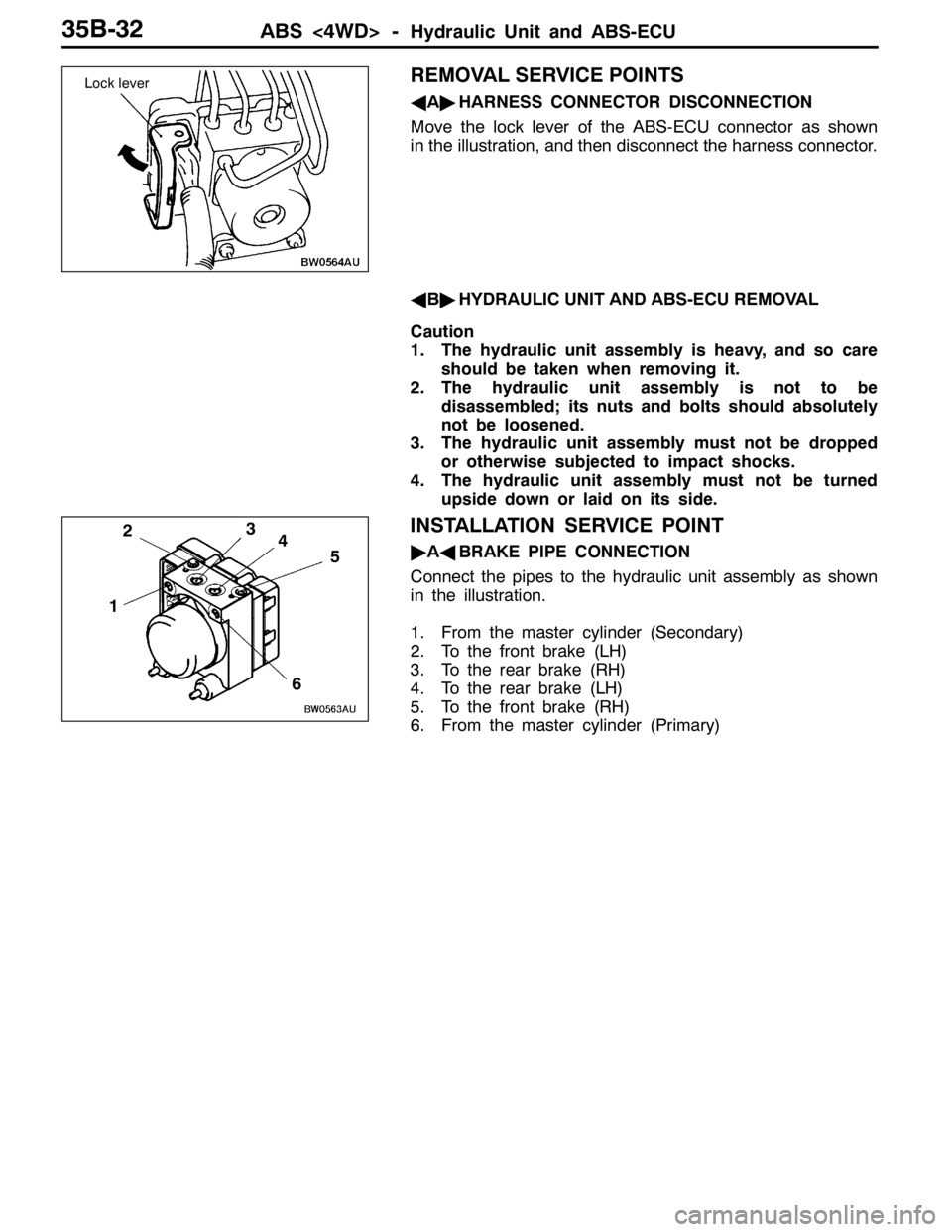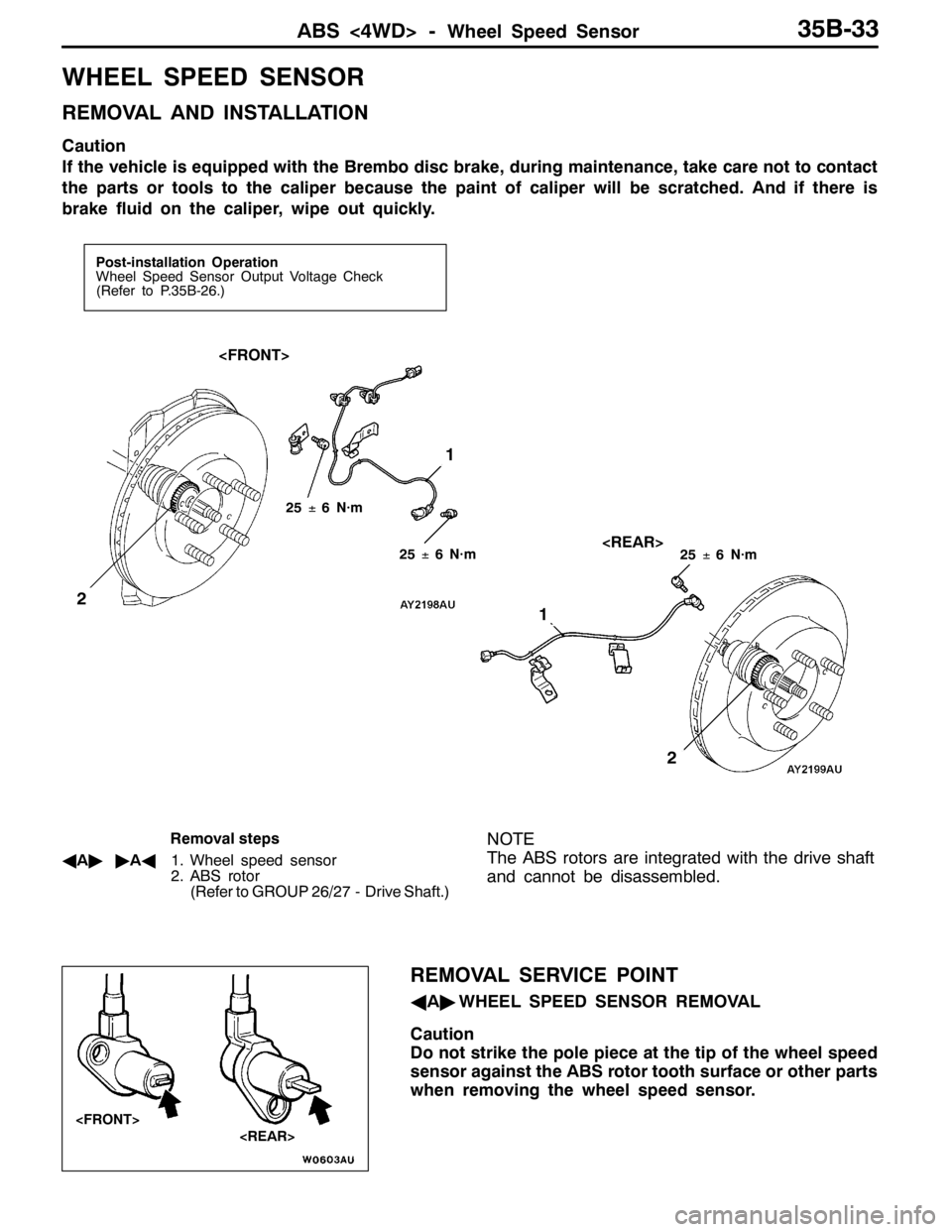MITSUBISHI LANCER EVOLUTION 2007 Service Repair Manual
Manufacturer: MITSUBISHI, Model Year: 2007, Model line: LANCER EVOLUTION, Model: MITSUBISHI LANCER EVOLUTION 2007Pages: 1449, PDF Size: 56.82 MB
Page 1101 of 1449

ABS <4WD> -Hydraulic Unit and ABS-ECU35B-31
Pre-removal Operation
DStrut Tower Bar Removal (Refer to GROUP 42.)
DBrake Fluid Draining
DAir Intake Hose and Air Cleaner RemovalPost-installation Operation
DBrake Fluid Supplying and Brake Line Bleeding
(Refer to GROUP 35A - On-vehicle Service.)
DHydraulic Unit Check (Refer to P.35B-28.)
DAir Intake Hose and Air Cleaner Installation
DStrut Tower Bar Installation (Refer to GROUP 42.)
213
4 2
2
2
15±2 N·m
25±6 N·m
25±6 N·m
Removal steps
AA"1. Harness connector
"AA2. Brake pipe connectionAB"3. Hydraulic unit and ABS-ECU
4. Hydraulic unit bracket assembly
Page 1102 of 1449

ABS <4WD> -Hydraulic Unit and ABS-ECU35B-32
REMOVAL SERVICE POINTS
AA"HARNESS CONNECTOR DISCONNECTION
Move the lock lever of the ABS-ECU connector as shown
in the illustration, and then disconnect the harness connector.
AB"HYDRAULIC UNIT AND ABS-ECU REMOVAL
Caution
1. The hydraulic unit assembly is heavy, and so care
should be taken when removing it.
2. The hydraulic unit assembly is not to be
disassembled; its nuts and bolts should absolutely
not be loosened.
3. The hydraulic unit assembly must not be dropped
or otherwise subjected to impact shocks.
4. The hydraulic unit assembly must not be turned
upside down or laid on its side.
INSTALLATION SERVICE POINT
"AABRAKE PIPE CONNECTION
Connect the pipes to the hydraulic unit assembly as shown
in the illustration.
1. From the master cylinder (Secondary)
2. To the front brake (LH)
3. To the rear brake (RH)
4. To the rear brake (LH)
5. To the front brake (RH)
6. From the master cylinder (Primary)
Lock lever
1
234
5
6
Page 1103 of 1449

ABS <4WD> -Wheel Speed Sensor35B-33
WHEEL SPEED SENSOR
REMOVAL AND INSTALLATION
Caution
If the vehicle is equipped with the Brembo disc brake, during maintenance, take care not to contact
the parts or tools to the caliper because the paint of caliper will be scratched. And if there is
brake fluid on the caliper, wipe out quickly.
Post-installation Operation
Wheel Speed Sensor Output Voltage Check
(Refer to P.35B-26.)
1
2
1
2
25±6 N·m
25±6 N·m25±6 N·m
Removal steps
AA""AA1. Wheel speed sensor
2. ABS rotor
(Refer to GROUP 26/27 - Drive Shaft.)NOTE
The ABS rotors are integrated with the drive shaft
and cannot be disassembled.
REMOVAL SERVICE POINT
AA"WHEEL SPEED SENSOR REMOVAL
Caution
Do not strike the pole piece at the tip of the wheel speed
sensor against the ABS rotor tooth surface or other parts
when removing the wheel speed sensor.
Page 1104 of 1449

ABS <4WD> -Wheel Speed Sensor35B-34
INSTALLATION SERVICE POINT
"AAWHEEL SPEED SENSOR
INSTALLATION
Install the wheel speed sensor crossing with the parking brake
cable.
INSPECTION
CHECK OF RESISTANCE BETWEEN WHEEL SPEED
SENSOR TERMINALS
Caution
The pole piece can become magnetized because of the
magnet built into the wheel speed sensor, with the result
that metallic foreign material easily adheres to it.
Moreover, the pole piece may not be able to function to
correctly sense the wheel rotation speed if it is damaged.
1. Measure the resistance between the wheel speed sensor
terminals.
Standard value: 1.24 - 1.64 kΩ
If the internal resistance of the wheel speed sensor is
not within the standard value, replace with a new wheel
speed sensor.
2. Check the wheel speed sensor cable for breakage,
damage or disconnection; replace with a new one if a
problem is found.
NOTE
When checking for cable damage, remove the cable clamp
part from the body and then bend and pull the cable
near the clamp to check whether or not temporary
disconnection occurs. Also check the connection of the
connector and that the terminals are inserted correctly.
ABS ROTOR CHECK
Check whether ABS rotor teeth are broken or deformed, and,
if so, replace the ABS rotor.
WHEEL SPEED SENSOR INSULATION INSPECTION
1. Remove all connections from the wheel speed sensor,
and then measure the resistance between terminal 1 and
the body of the wheel speed sensor, and terminal 2 and
the body of the wheel speed sensor.
Standard value: 100 kΩor more
2. If the speed sensor insulation resistance is outside the
standard value range, replace with a new speed sensor.
Wheeel speed sensor
Parking brake cable
Page 1105 of 1449

ABS <4WD> -G Sensors and Steering Wheel Sensor35B-35
G SENSORS AND STEERING WHEEL
SENSOR
REMOVAL AND INSTALLATION
Refer to GROUP 22 - Sensor, Switch and Relay.
Parking brake lever
Lateral G sensorLongitudinal G sensor
Steering wheel sensor
Page 1106 of 1449

NOTES
Page 1107 of 1449

36-1
PARKING BRAKES
CONTENTS
GENERAL INFORMATION 2..................
SERVICE SPECIFICATIONS 2.................
LUBRICANTS 2..............................
ON-VEHICLE SERVICE 3.....................
Parking Brake Lever Stroke Check and
Adjustment 3..................................Parking Brake Switch Check 3..................
Lining Running-In 4............................
PARKING BRAKE LEVER 5..................
PARKING BRAKE CABLE 6..................
PARKING BRAKE DRUM 7...................
Page 1108 of 1449

PARKING BRAKES -General Information/Service Specifications/Lubricants36-2
GENERAL INFORMATION
The parking brake is of a mechanical control type
acting on the rear wheels. A lever is used to apply
the parking brake.
CONSTRUCTION DIAGRAM
Parking brake lever
Parking brake lever
SERVICE SPECIFICATIONS
ItemsStandard valueLimit
Parking brake lever stroke5 - 7 notches-
Rear brake lining thickness mm2.81.0
Rear drum inside diameter mm168.0169.0
LUBRICANTS
ItemsSpecified lubricants
Backing plateMultipurpose grease
Shoe and lining assembly
Adjuster
Page 1109 of 1449

PARKING BRAKES -On-Vehicle Service36-3
ON-VEHICLE SERVICE
PARKING BRAKE LEVER STROKE CHECK
AND ADJUSTMENT
1. Pull the parking brake lever with a force of approx. 200
N and count the number of notches.
Standard value: 5 - 7 notches
2. If the parking brake lever stroke is not the standard value,
adjust as described below.
(1) Remove the floor console assembly. (Refer to
GROUP52A)
(2) Loosen the adjusting nut to move it to the cable rod
end so that the cable will be free.
(3) Depress the brake pedal repeatedly until the lever
has no change in its stroke.
NOTE
Depressing the brake pedal repeatedly adjusts shoe
clearance correctly.
(4) Turn the adjusting nut to adjust the parking brake lever
stroke to the standard value. After adjusting, check
that there is no space between the adjusting nut and
the parking brake lever. Check that the adjusting nut is
secured with the nut holder.
Caution
If the parking brake lever stroke is below the
standard value and the braking is too firm, the
rear brakes may drag.
(5) After adjusting the parking brake lever stroke, jack
up the rear end of the vehicle, and then release the
parking brake and turn the rear wheels to check that
the rear brakes are not dragging.
PARKING BRAKE SWITCH CHECK
1. Remove the floor console assembly. (Refer to
GROUP52A)
2. Remove the front seat assembly(RH). (Refer to
GROUP52A)
3. Check for continuity between the parking brake switch
terminal and the switch mounting bolt.
When parking brake lever is pulledContinuity
When parking brake lever is releasedNo continuity
Adjusting nut
Cable rod
Page 1110 of 1449

PARKING BRAKES -On-Vehicle Service36-4
LINING RUNNING-IN
Carry out running-in by the following procedure when replacing
the parking brake linings or the rear brake disc rotors, or
when brake performance is insufficient.
Caution
Carry out running-in in a place with good visibility, and
pay careful attention to safety.
1. Adjust the parking brake stroke to the specified value.
Standard value [Operation force: Approx. 200 N] :
5 - 7 notches
2. Hook a spring balance onto the centre of the parking
brake lever grip and pull it with a force of 100 - 150
N in a direction perpendicular to the handle.
3. Drive the vehicle at a constant speed of 35 - 50 km/h
for 100 metres.
4. Release the parking brake and let the brakes cool for
5 - 10 minutes.
5. Repeat the procedure in steps 2 to 4 four or five times.
Pull
Spring balance
Approx.
40 mm